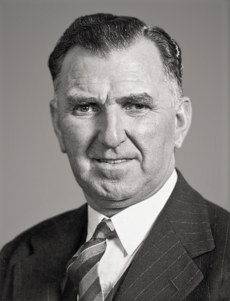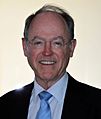New Zealand National Party facts for kids
Quick facts for kids
New Zealand National Party
Rōpū Nāhinara o Aotearoa
|
|
|---|---|
 |
|
| President | Sylvia Wood |
| Leader | Christopher Luxon |
| Deputy Leader | Nicola Willis |
| Founded | 14 May 1936 |
| Preceded by | United–Reform Coalition |
| Headquarters | 41 Pipitea Street, Thorndon, Wellington 6011 |
| Youth wing | Young Nationals |
| Ideology |
|
| Political position | Centre-right |
| Regional affiliation | Asia Pacific Democracy Union |
| International affiliation | International Democracy Union |
| Colours | Blue |
| Slogan | Get our country back on track |
| House of Representatives |
49 / 123
|
The New Zealand National Party (in Māori: Rōpū Nāhinara o Aotearoa), usually just called National or the Nats, is a major political party in New Zealand. It is considered a centre-right party, which means it often supports business and individual freedoms. National is one of the two main parties in New Zealand politics, along with its rival, the Labour Party.
The National Party was created in 1936 when two other parties, the Reform Party and the United Party, joined together. This makes it New Zealand's second-oldest political party that still exists today. Over the years, National has been in charge of the government more often than any other party.
Christopher Luxon has been the leader of the National Party since November 2021. He led the party to a win in the 2023 election. Since then, he has been the Prime Minister, leading a government in partnership with the ACT Party and New Zealand First.
Contents
- History of the National Party
- How the Party Was Formed
- First Time in Government (1949–1957)
- Second Time in Government (1960–1972)
- Third Time in Government (1975–1984)
- Fourth Time in Government (1990–1999)
- Years in Opposition (1999–2008)
- Fifth Time in Government (2008–2017)
- Return to Opposition (2017–2023)
- Sixth Time in Government (2023–present)
- What the National Party Believes In
- Party Organisation
- Electoral performance
- Leadership
- Images for kids
- See also
History of the National Party
How the Party Was Formed
The National Party was officially formed in May 1936. It was created by merging two older parties: the United Party and the Reform Party. The United Party was popular in cities with business owners and the middle class. The Reform Party was mainly supported by farmers in rural areas.
These two parties decided to work together in the 1930s to compete against the growing Labour Party. They ran in the 1935 election as the "National Political Federation" but lost badly. This was partly because of the tough times of the Great Depression. After the loss, they decided to officially become one party, creating the New Zealand National Party.
Adam Hamilton became the party's first leader. However, he struggled to compete with the popular Labour Prime Minister, Michael Joseph Savage. In 1940, Sidney Holland took over as leader. Under Holland, the party gained more support in the elections of 1943 and 1946. Finally, in the 1949 election, National won, and Sidney Holland became the first National Party Prime Minister.
First Time in Government (1949–1957)
The new National government, led by Prime Minister Sidney Holland, was generally conservative. It kept many of the social programs, like the welfare state, that the previous Labour government had created.
In 1951, a major workers' strike called the Waterfront Dispute happened. The government took a strong stand against the striking unions. Holland used this event to call a special election, which National won easily.
Holland's government was re-elected in 1954. Near the end of his term, Holland became ill and stepped down. Keith Holyoake took over as Prime Minister, but he lost the election later that year to the Labour Party.
Second Time in Government (1960–1972)

Labour's time in power was short. Many people were unhappy with their economic decisions. In the 1960 election, Keith Holyoake and the National Party returned to power.
Holyoake's government was very successful and lasted for 12 years. The party won re-election three times in a row. In 1972, Holyoake retired and was replaced by his deputy, Jack Marshall. However, Marshall lost the election later that year to the popular Labour leader, Norman Kirk.
Third Time in Government (1975–1984)
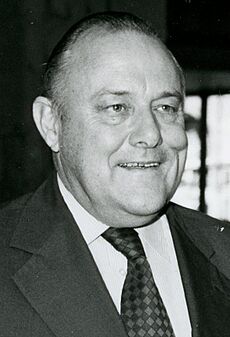
After losing the election, National chose a new leader, Robert Muldoon. Muldoon was a strong and forceful politician. He defeated Labour in the 1975 election and became Prime Minister.
Muldoon's government was known for its "Think Big" projects. These were large-scale industrial projects designed to make New Zealand more self-sufficient in energy. However, Muldoon's leadership style was seen by some as too controlling.
Even though public dissatisfaction was growing, National won the 1978 and 1981 elections. But by 1984, some of his own MPs began to disagree with him. When one MP refused to support his policy on nuclear ship visits, Muldoon called a surprise election. National lost this election to the Labour Party, led by David Lange.
Fourth Time in Government (1990–1999)
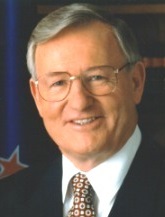
After the 1984 loss, Jim Bolger became the new leader of the National Party. In the 1990 election, National had a huge win and Bolger became Prime Minister.
His government continued many of the free-market economic changes that the previous Labour government had started. These policies, known as "Ruthanasia" after Finance Minister Ruth Richardson, involved selling state-owned companies and making big cuts to government spending. These changes were not popular with all of National's traditional supporters.
In 1996, New Zealand had its first election under the new MMP system. This system makes it harder for one party to win a majority. National had to form a coalition (a partnership) with the New Zealand First party to govern.
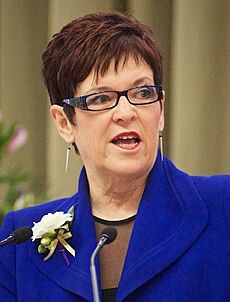
In 1997, Jenny Shipley took over from Jim Bolger to become National's leader and New Zealand's first female Prime Minister. However, the coalition with New Zealand First soon fell apart. Shipley's government managed to finish its term but lost the 1999 election to Labour's Helen Clark.
Years in Opposition (1999–2008)
National spent nine years as the opposition party. After Shipley, Bill English became leader, but the party had its worst-ever election result in 2002. In 2003, Don Brash, a former head of the Reserve Bank, took over as leader.
Under Brash, the party's popularity grew. He focused on issues like tax cuts and race relations. In the 2005 election, National did much better but still didn't win enough seats to form a government. In 2006, John Key became the new leader, promising a more "centrist" approach that appealed to more voters.
Fifth Time in Government (2008–2017)
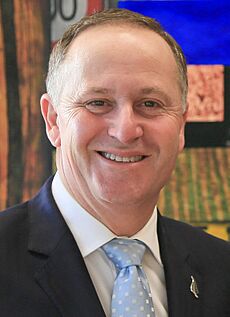
In the 2008 election, John Key led National to victory. He formed a government with support from the ACT, United Future, and Māori parties. Key's government focused on managing the economy during the global financial crisis. They also cut taxes and partially sold some state-owned energy companies.
National won again in the 2011 and 2014 elections. Key's government introduced free doctor visits for children under 13 and worked on international trade deals.
In December 2016, John Key surprised the country by resigning as Prime Minister. His deputy, Bill English, took over as leader.
Return to Opposition (2017–2023)
In the 2017 election, National won the most seats but not enough to govern alone. New Zealand First chose to form a coalition with the Labour Party, so National became the opposition party again. Bill English was replaced as leader by Simon Bridges in 2018.
The party went through several leadership changes. Todd Muller briefly replaced Bridges in May 2020, followed by Judith Collins in July 2020. Collins led the party into the 2020 election, where it suffered a major defeat.
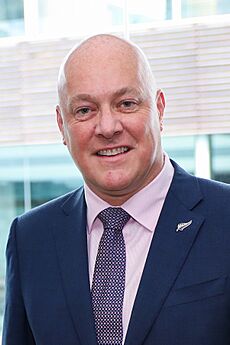
In November 2021, Christopher Luxon was elected as the new leader of the National Party, with Nicola Willis as his deputy.
Sixth Time in Government (2023–present)
During the 2023 election, Christopher Luxon led the National Party to victory over the Labour Party. National won the most seats but needed partners to form a government.
They formed a three-party coalition government with the ACT Party and New Zealand First. This was the first time a three-party coalition had governed New Zealand under the MMP system.
What the National Party Believes In
The National Party is often called a "broad church" because it includes people with a mix of conservative and liberal ideas.
- Conservatives often value tradition, stability, and strong families.
- Liberals in the party tend to support economic liberalism, which means they favour free enterprise, lower taxes, and less government control over the economy.
The party's main principles include:
- Loyalty to New Zealand and the Monarch as Head of State.
- Recognising the Treaty of Waitangi as New Zealand's founding document.
- Belief in personal responsibility, individual freedom, and equal opportunities for all citizens.
- Supporting a competitive economy and a limited role for government.
Historically, National governments sometimes supported more government action in the economy, like the "Think Big" projects in the 1980s. But since the 1990s, the party has mostly focused on free-market ideas.
Party Organisation

The National Party has a large membership base across the country. The party is run by a Board of Directors, which includes the party leader and other elected members.
The party has a youth wing called the Young Nationals, often known as the "Young Nats." This group gives young people a voice in the party and helps develop future leaders.
National is also part of international groups like the International Democracy Union, which connects centre-right parties from around the world.
Electoral performance
House of Representatives
| Election | Leader | Votes | % | Seats | +/– | Position | Status |
|---|---|---|---|---|---|---|---|
| 1938 | Adam Hamilton | 381,081 | 40.30% |
25 / 80
|
Opposition | ||
| 1943 | Sidney Holland | 402,887 | 42.78% |
34 / 80
|
Opposition | ||
| 1946 | 507,139 | 48.43% |
38 / 80
|
Opposition | |||
| 1949 | 556,805 | 51.88% |
46 / 80
|
Majority | |||
| 1951 | 577,630 | 53.99% |
50 / 80
|
Majority | |||
| 1954 | 485,630 | 44.27% |
45 / 80
|
Majority | |||
| 1957 | Keith Holyoake | 511,699 | 44.21% |
39 / 80
|
Opposition | ||
| 1960 | 557,046 | 47.59% |
46 / 80
|
Majority | |||
| 1963 | 563,875 | 47.12% |
45 / 80
|
Majority | |||
| 1966 | 525,945 | 43.64% |
44 / 80
|
Majority | |||
| 1969 | 605,960 | 45.22% |
45 / 84
|
Majority | |||
| 1972 | Jack Marshall | 581,422 | 41.50% |
32 / 87
|
Opposition | ||
| 1975 | Robert Muldoon | 763,136 | 47.59% |
55 / 87
|
Majority | ||
| 1978 | 680,991 | 39.82% |
51 / 92
|
Majority | |||
| 1981 | 698,508 | 38.77% |
47 / 92
|
Majority | |||
| 1984 | 692,494 | 35.89% |
37 / 95
|
Opposition | |||
| 1987 | Jim Bolger | 806,305 | 44.02% |
40 / 97
|
Opposition | ||
| 1990 | 872,358 | 47.82% |
67 / 97
|
Majority | |||
| 1993 | 673,892 | 35.05% |
50 / 99
|
Majority | |||
| 1996 | 701,315 | 33.87% |
44 / 120
|
Coalition (1996–1998) | |||
| Minority (1998–1999) | |||||||
| 1999 | Jenny Shipley | 629,932 | 30.50% |
39 / 120
|
Opposition | ||
| 2002 | Bill English | 425,310 | 20.93% |
27 / 120
|
Opposition | ||
| 2005 | Don Brash | 889,813 | 39.10% |
48 / 121
|
Opposition | ||
| 2008 | John Key | 1,053,398 | 44.93% |
58 / 122
|
Minority | ||
| 2011 | 1,058,638 | 47.31% |
59 / 121
|
Minority | |||
| 2014 | 1,131,501 | 47.04% |
60 / 121
|
Minority | |||
| 2017 | Bill English | 1,152,075 | 44.45% |
56 / 120
|
Opposition | ||
| 2020 | Judith Collins | 738,275 | 25.58% |
33 / 120
|
Opposition | ||
| 2023 | Christopher Luxon | 1,085,016 | 38.06% |
48 / 123
|
Coalition | ||
| Source: Electoral Commission | |||||||
Leadership
Party leaders since 1936
A list of the people who have led the National Party since it began. Key:
National Labour
PM: Prime Minister
LO: Leader of the Opposition
| No. | Name | Portrait | Term of Office | Position | Prime Minister | ||
|---|---|---|---|---|---|---|---|
| 1 | Adam Hamilton |  |
2 November 1936 | 26 November 1940 | LO 1936–1940 | Savage | |
| Fraser | |||||||
| 2 | Sidney Holland | 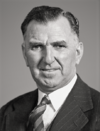 |
26 November 1940 | 20 September 1957 | LO 1940–1949 | ||
| PM 1949–1957 | Holland | ||||||
| 3 | Keith Holyoake | 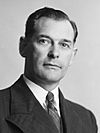 |
20 September 1957 | 7 February 1972 | PM 1957 | Holyoake | |
| LO 1957–1960 | Nash | ||||||
| PM 1960–1972 | Holyoake | ||||||
| 4 | Jack Marshall | 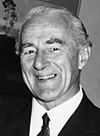 |
7 February 1972 | 4 July 1974 | PM 1972 | Marshall | |
| LO 1972–1974 | Kirk | ||||||
| 5 | Robert Muldoon | 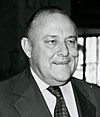 |
4 July 1974 | 29 November 1984 | LO 1974–1975 | ||
| Rowling | |||||||
| PM 1975–1984 | Muldoon | ||||||
| LO 1984 | Lange | ||||||
| 6 | Jim McLay | 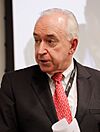 |
29 November 1984 | 26 March 1986 | LO 1984–1986 | ||
| 7 | Jim Bolger | 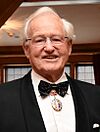 |
26 March 1986 | 8 December 1997 | LO 1986–1990 | ||
| Palmer | |||||||
| Moore | |||||||
| PM 1990–1997 | Bolger | ||||||
| 8 | Jenny Shipley |  |
8 December 1997 | 8 October 2001 | PM 1997–1999 | Shipley | |
| LO 1999–2001 | Clark | ||||||
| 9 | Bill English |  |
8 October 2001 | 28 October 2003 | LO 2001–2003 | ||
| 10 | Don Brash | 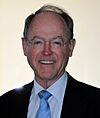 |
28 October 2003 | 27 November 2006 | LO 2003–2006 | ||
| 11 | John Key | 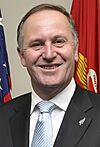 |
27 November 2006 | 12 December 2016 | LO 2006–2008 | ||
| PM 2008–2016 | Key | ||||||
| (9) | Bill English |  |
12 December 2016 | 27 February 2018 | PM 2016–2017 | English | |
| LO 2017–2018 | Ardern | ||||||
| 12 | Simon Bridges | 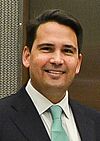 |
27 February 2018 | 22 May 2020 | LO 2018–2020 | ||
| 13 | Todd Muller | 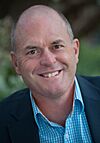 |
22 May 2020 | 14 July 2020 | LO 2020 | ||
| 14 | Judith Collins | 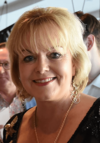 |
14 July 2020 | 25 November 2021 | LO 2020–2021 | ||
| 15 | Christopher Luxon | 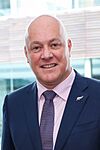 |
30 November 2021 | Incumbent | LO 2021–2023 | ||
| Hipkins | |||||||
| PM 2023–present | Luxon | ||||||
Images for kids
-
Sir Jim McLay
served 1984–1986 -
Jim Bolger
served 1986–1997 -
Dame Jenny Shipley
served 1997–2001 -
Sir Bill English
served 2001–03; 2016–18 -
Sir John Key
served 2006–2016 -
Simon Bridges
served 2018–2020 -
Todd Muller
served 2020 -
Judith Collins
served 2020–2021
See also
 In Spanish: Partido Nacional de Nueva Zelanda para niños
In Spanish: Partido Nacional de Nueva Zelanda para niños
- Politics of New Zealand
- List of conservative parties by country
- Liberal parties by country



